Cape to Cairo Journey:
Pages to Explore:
Blog Catagories:
Photo of the day








Home | About Us | Safaris & Photographic Trips | Blog | Contact Us | Sitemap | Disclaimer
The Essence of the Journey!
We would like to do this trip to experience new cultures.
We would like to understand what makes African people pure.
What are their spiritual beliefs, understandings?
How does the spiritual world we know exist to them?
What can we learn from them?

May 12 12
Black cotton soils – Kafue – Zambia
Kafue National Park – Zambia
“You can go on any road in Kafue National Park”
It was April and there were no more rains.¬Ý This was somewhat liberating, considering that there was much consternation and deliberation as to which was the best route to take into and around Kafue.¬Ý Kafue is really large, in fact at 22 400 km2 it is about the size of Wales.¬Ý The roads in Wales you can drive on easily, so can you in Kafue, apparently.¬Ý Having spent the night at Itezhi-Tezhi we ventured through the Musa gate.¬Ý We spent the evening at the New Kalala camp where we met Lawrence and his wife (fantastic farming folk from Lusaka).¬Ý
“Can I get to Nanzhila for lunch?” I semi-joked with the ZAWA official at the gate.
‚ÄúEasily she replied‚Äù.¬Ý It was 09h00.
So, full of the new, first-hand information, we set out for Nanzhila, ‚Äòeasily arriving for lunch‚Äô.¬Ý Having time on our side, and the fact that all roads were doable, we opted for the more scenic river road.¬Ý Well, going was slow.¬Ý There was tall, grass, lots of it (mostly Hyparrhenia hirtha) and there was a fair amount of sandy ridges. ¬ÝIt was great to see a small herd of 5 Sable.¬Ý By 15h00, we had not reached Nanzhila for lunch; we were however about 5km away as the crow flies.¬Ý We had hit a few wet patches, but nothing that Staffie, could not get through.¬Ý OK, there was one place we had to winch
ourselves through.¬Ý This dambo (flooded grassy swamp with sticky black cotton soil) was different though.¬Ý Celeste kindly walked through the beginning section, unfortunately not the last 2/3rds of it.¬Ý With vigour and momentum I attacked said dambo.¬Ý Half way through, and we ground to a halt.¬Ý Thigh deep in places (waist deep for Nicolai) we were in trouble.¬Ý With 250m left to exit the dambo, the winch could not reach any trees or notable supports.¬Ý What to do now?
Driving slow roads is draining, but grinding to a halt, miles from help, takes that wind from you. ¬Ý¬ÝWithin a few minutes though, you realize that you have to solve the problem yourself, so get on with it.¬Ý Bury the spare wheel in the swamp and try winch out from there?¬Ý
We had noticed some lion prints (great samples) embedded in the clayey soil just prior to entering the swamp.¬Ý We waded through water to where there were some fallen trees and started collecting and breaking off, bits of trees.¬Ý The plan was that we would hi-lift the wheels of the vehicle, jabbing branches under each of the wheels, and then drive out ‚Äì easy.¬Ý I pulled Cel out of earshot from the kids and whispered ‚Äú ‚Ķ we may be here overnight, so prepare yourself, this may take a while.‚Äù
With some more solid matter under each wheel, we gave it a go.¬Ý The wheels ground and
mushed and turned freely, not this time.¬Ý The light was fading – it was past 5pm.¬Ý
What a surprise to see approaching figures, Oliver and his 3 sons.¬Ý Local fishermen. ¬ÝWe were stuck, as if I needed to tell them.¬Ý Oliver had worked at Nanzhila, and confirmed that the lodge was not far, but smiled and shook his head, almost in disbelief that we had come so far on the road, ‚Äúyou cannot use this road for another 2 months‚Äù he said.¬Ý ‚ÄúBut the ZAWA officer said that it was passable,‚Äù I contested with a smile.¬Ý Knowing full well that this was no longer the issue, but rather the 3,5 tons stuck in the swamp.
Kafue opens up it‚Äôs borders to local fishermen for one month of the year and allow them to fish extensively within the park during this time.¬Ý This really sounded positive to me and was a way of keeping the community involved and interested in conservation of the park.¬Ý There were other initiatives in the park too, this seemed like a good one.¬Ý Oliver offered to help, and immediately his 3 sons disappeared.¬Ý They could not speak English, unlike the benefit Oliver had received as a result of his employment at the lodge.
The returning fishermen brought with them young Mopane tree branches, and with the shovel proceeded to force them under each wheel.¬Ý With the trailer now unhitched from the vehicle, I expectantly got into the driver seat.¬Ý Rock forward, back, forward quickly ‚Äì no joy.¬Ý Two wheels in particular were misbehaving badly.¬Ý The sun was now gone.¬Ý Fiery Necked Nightjars were now calling and we could hear a hyena calling in the distance.
With the shovel not getting deep enough, we started to jack each wheel up and again inserting fresh branches.¬Ý The rear right jacking point gave way.¬Ý With a ‚Äòkonk‚Äô in the body work, the nut disappeared into the bog.¬Ý ‚ÄúIt‚Äôs 4×4.¬Ý 3 wheels propped and stacked will be enough‚Äù I said assuringly.¬Ý In truth not knowing, but their faces grew more sullen as their hopes seemed to disappear into the swamp with said bolt.¬Ý We were now shadows, and the waxing moon had not been of assistance.¬Ý I had to try to raise my spirits; hopefully the others‚Äô would follow.¬Ý Sloshing into the front seat, I realized this was probably the last chance for the evening.¬Ý Having tried unsuccessfully on 2nd start, I was now in tank mode.¬Ý Low range, diffs engaged, slowly I pressed the accelerator.¬Ý The wheels were loose, then a little bit of traction, then slipping, then some traction.¬Ý ‚ÄúWhoa, whoa ‚Ķ ‚Äú or something similar was the shout.¬Ý I glanced in my rear view mirror, the back right wheel was slipping badly.¬Ý Austen, the one son that was pushing from the back right was getting pasted in mud, as the wheel turned spastically amongst the black muck and freshly cut mopane.¬Ý The opinion was clearly to stop.¬Ý Not a ‚Äòdonder‚Äô, this was it – get free or sleep in the swamp.¬Ý Accelerator to the floor, the shouts were louder.¬Ý Like teeth sinking into a hot newly bought gum guard, the Goodrichs bit and let go, bumping and bouncing, with cheering bodies crouched in the mud behind me, I got to the other side. ¬Ý¬Ý¬Ý
With the help of our newly met local friends, I snaked my way through young trees around
the swamp back to the start point.¬Ý With the winch round the trailer, her nose was lifted out the mud as we pulled her slowly free.¬Ý Oliver got a lift back with us to a scout‚Äôs camp 7 km back, with his near rotten drying fish on our trailer nose cover – a smell that, to this day, follows us despite several washes to the cover.¬Ý I was so happy with the effort and passion and each fisherman received 50 000 Kwacha reward.¬Ý This was well received and the following morning Oliver gave us a tour of his fishing camp and their traditional fishing methods.¬Ý This was fascinating to say the least.¬Ý
The fishermen block off the river flow (typically 75 or so metres wide) with trees.¬Ý They leave a small gap, about half a metre wide and 3m in length. Into the gap, the water rushes through, as do the fish, which fall into a weaved basket type weir, unable to escape.¬Ý They average about 200 fish/hour in the evenings.¬Ý I was told there are about 14 such ‚Äòtraps‚Äô along the river, which are dismantled at the end of the season.¬Ý It was disheartening to see that even the smallest fish are taken, but a relief that it is only for 30 days.
The David Shepherd foundation has been synonymous with Kafue, and with David now 81, having given his life to the reserve.¬Ý The elephant sanctuary has been running the last four years and Liz took us on a thorough tour, explaining that only elephants that can be self-sustaining in the future are assisted.¬Ý Generally the youngsters are rescued when their mothers are shot by poachers, which continues to be a major problem in Southern Africa.¬Ý They currently have a facility in Lusaka
for young that are less than 3 years and still on formula and the more adolescent ones are kept at the Kafue facility.¬Ý Each visitor wears a green overcoat so that bright colours are associated with other, less friendly people.¬Ý Over the past few months they have received an elephant a month.¬Ý They rely heavily on donations and are providing an outstanding service.
The northern section of Kafue is where Jacques and Linda van Heerden run Mukambi Lodge.¬Ý Two folk that are so comfortable in their own skin.¬Ý Smiling, happy, run a smooth operation type of folk.¬Ý Staff are happy, and even Basil the hippo finds the vibes so good that he plonks himself down on their reception area.¬Ý We were treated to the Villa for a night, on the Kafue river, with all the luxuries.¬Ý We met the Swanepoels at Mukambe too.¬Ý It seems lekker people just stick together.¬Ý
In spite having a grass net, the grass seeds had filled the radiator.¬Ý We travelled back to
Lusaka slowly, 80km/h and less than 2000 rpm.¬Ý Dan Wyllie helped us big time.¬Ý The best mechanic I have ever met, and really a top bloke too.¬Ý Absolutely thorough.¬Ý Robyn his wife runs the back office, and Anna and Faye are two of the dearest young girls you could meet.¬Ý Thank you Dan for your donation of time and skill, professionalism and hospitality.¬Ý It is a privilege to know you guys.
Oh yes, and Celeste cracked the windscreen smashing a tsetse fly …



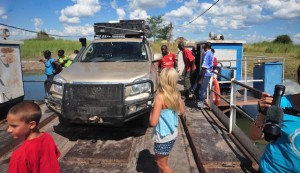

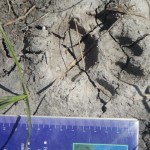
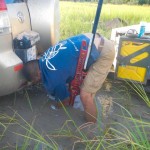
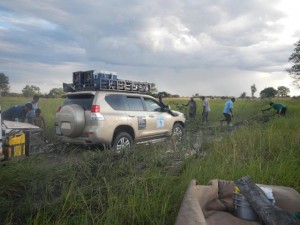
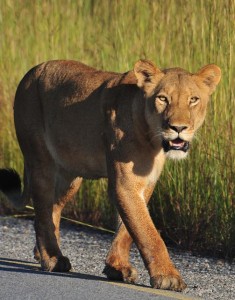
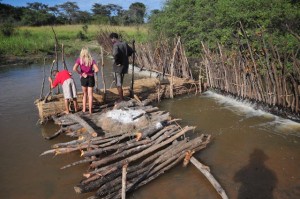
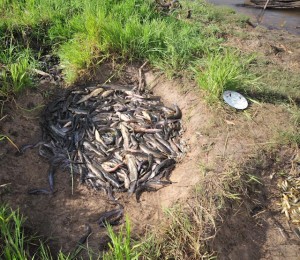
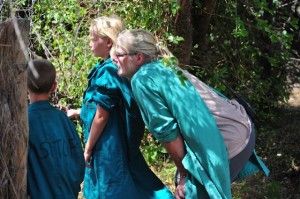
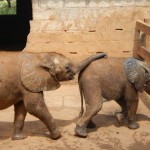
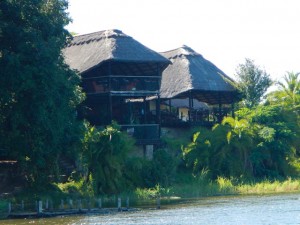
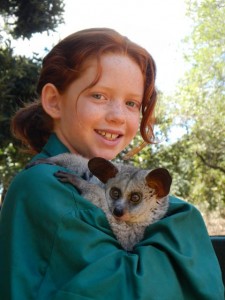



You make Bear Gryls look like a boyscout. By the ends of this trip, I bet you will be able to get that prado and trailer out of quicksand, with your eye blindfolded and fighting off a 5m boaconstrictor at the same time cooking a chicken pasta.